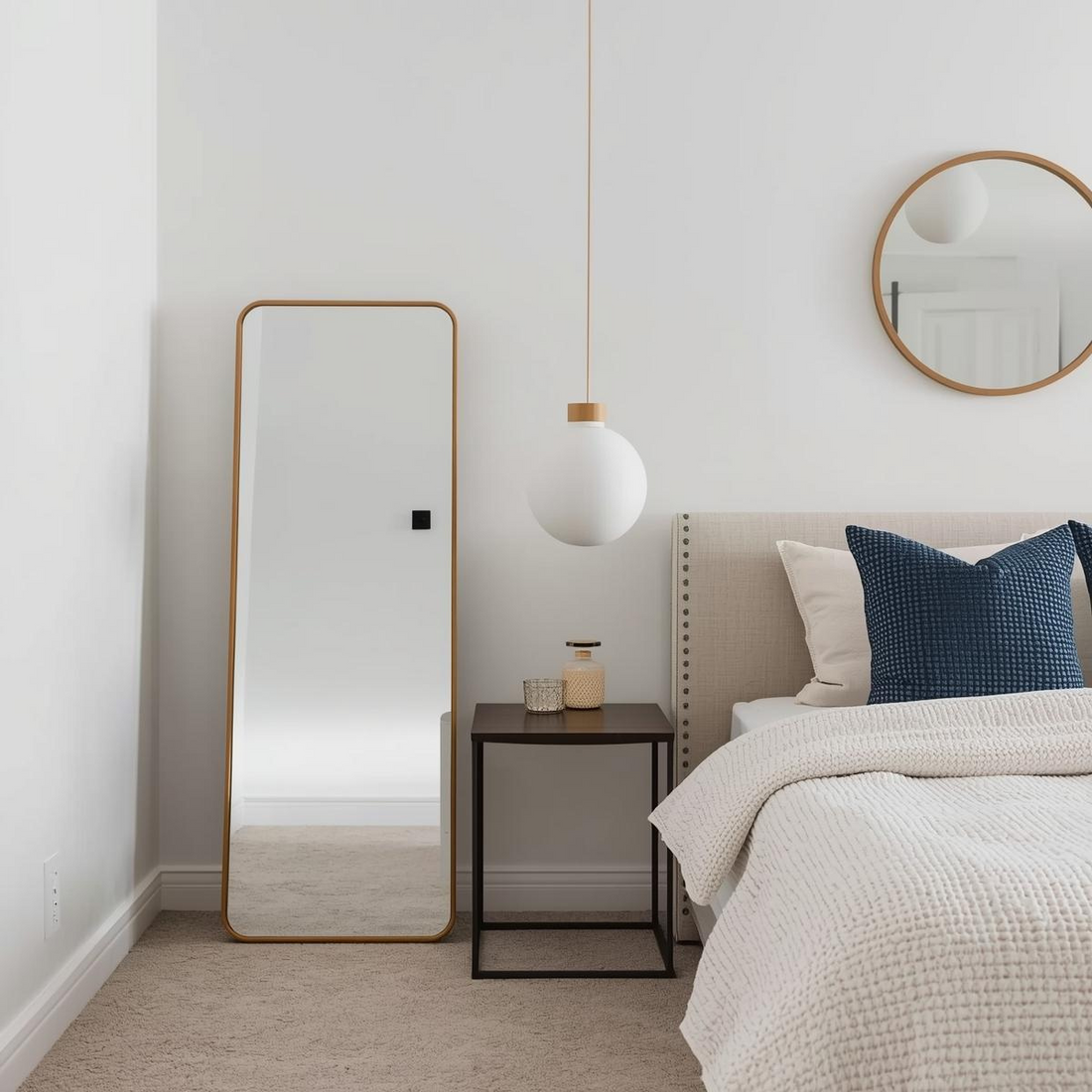
Full Length Mirror vs Wall Mirror: Bedroom Guide 2025
Share
Full length mirror vs wall mirror—which one is right for your bedroom? Both are popular, stylish, and practical, but each works differently depending on your space, lifestyle, and design goals.
This blog will walk you through mirror types, key differences, design psychology, expert styling tips, and FAQs so you can choose confidently.
Why the Right Bedroom Mirror Matters

Mirrors aren’t just decorative—they shape how we live and feel in our bedrooms. They:
- Expand visual space in small bedrooms.
- Reflect natural light for brightness.
- Provide daily functionality for dressing and styling.
- Influence mood, privacy, and even sleep.
Full-Length Mirrors: Classic Choice for Functionality
 A full-length mirror (sometimes called a dressing mirror) is tall enough to reflect your entire body. It can be freestanding, leaning, or mounted on a door.
A full-length mirror (sometimes called a dressing mirror) is tall enough to reflect your entire body. It can be freestanding, leaning, or mounted on a door.
Pros
- Practicality: Perfect for outfit checks.
- Design Presence: Adds vertical drama, elongating the room.
- Portability: Can be moved without drilling.
- Versatility: Lean casually against a wall or be part of a wardrobe.
Cons
- Needs floor space.
- Can feel overwhelming in very small bedrooms.
- Must be secured to avoid tipping.
Wall Mirrors: Space-Saving Style
Wall mirrors are mounted directly onto the wall. They range from minimalist frameless designs to ornate statement pieces.
Pros
- Space Efficiency: Saves floor area in small bedrooms.
- Endless Shapes & Sizes: Round, rectangular, arched, or custom.
- Placement Flexibility: Above dressers, side walls, or even as a feature wall.
- Design Variety: From understated to bold luxury.
Cons
- Requires drilling/installation.
- Often not full-body length.
- Improper placement may reflect clutter or light at night.
Full Length Mirror vs Wall Mirror: Side-by-Side Comparison
|
Feature |
Full-Length Mirror |
Wall Mirror |
|
Main Function |
Dressing & full outfit reflection |
Style & space-saving |
|
Space Needs |
Requires floor space |
Mounted, no floor space |
|
Flexibility |
Movable, renter-friendly |
Fixed, long-term |
|
Impact |
Bold, vertical presence |
Subtle, integrated décor |
|
Best For |
Large bedrooms, outfit checking |
Small bedrooms, design accents |
Design Psychology: How Each Affects Your Bedroom
-
Full-Length Mirrors
Boost confidence during daily routines; create height and grandeur. -
Wall Mirrors
Enhance ambiance, open up compact rooms, and balance furniture layouts. -
Combined Use
Many designers recommend using both—full-length for function, wall mirrors for aesthetics.
Styling Tips for Bedroom Mirrors
If You Choose Full-Length Mirrors
- Lean against a wall for casual luxury.
- Anchor with anti-tip kits for safety.
- Place opposite a window for maximum light reflection.
If You Choose Wall Mirrors
- Hang above a dresser to double as vanity.
- Use round or arched mirrors to soften sharp furniture lines.
- Avoid placing directly opposite the bed (per Feng Shui and sleep science).
Practical Considerations
- Lighting: Warm, dimmable lighting reduces glare.
- Maintenance: Use microfiber cloths; avoid harsh chemicals.
- Safety: Shatter-resistant glass recommended for kids’ rooms.
- Balance: Mirrors double whatever they reflect—keep areas tidy.
Conclusion
The full length mirror vs wall mirror debate doesn’t have one winner—it depends on your needs:
- Choose full-length mirrors if you value outfit practicality and bold design.
- Choose wall mirrors if you want style, versatility, and space-saving.
- Use both for the ultimate balance of functionality and elegance.
FAQs About Full Length Mirror vs Wall Mirror
Which is better for bedrooms, a full length mirror or wall mirror?
Full-length mirrors are best for dressing; wall mirrors save space and add style. Many bedrooms benefit from combining both.
Can wall mirrors make small bedrooms look bigger?
Yes. Wall mirrors reflect light and create the illusion of depth, perfect for compact spaces.
Do full-length mirrors take up too much space?
They need floor space but slim-frame designs work even in small bedrooms.
Where should I place a wall mirror in a bedroom?
Above a dresser, beside the bed, or opposite a window to maximize light.
Are freestanding mirrors safe for homes with kids or pets?
Yes, but secure them with anti-tip kits or wall anchors for stability.
